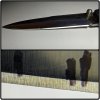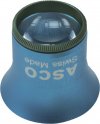-
The BladeForums.com 2024 Traditional Knife is ready to order! See this thread for details: https://www.bladeforums.com/threads/bladeforums-2024-traditional-knife.2003187/
Price is$300$250 ea (shipped within CONUS). If you live outside the US, I will contact you after your order for extra shipping charges.
Order here: https://www.bladeforums.com/help/2024-traditional/ - Order as many as you like, we have plenty.
You are using an out of date browser. It may not display this or other websites correctly.
You should upgrade or use an alternative browser.
You should upgrade or use an alternative browser.
Do you check you edge with magnification?
- Thread starter kane22
- Start date
- Joined
- Apr 15, 2012
- Messages
- 1,104
Magnification is a great resource to confirm/visualize actual condition. One of many sharpening/maintenance tools available, but not always used.
Below: Easier to see actually looking through a loupe than to photograph ... three tiny rolls on this edge that were not felt running edge along fingernail but could been identified via magnification.

Below: Easier to see actually looking through a loupe than to photograph ... three tiny rolls on this edge that were not felt running edge along fingernail but could been identified via magnification.

777 Edge
Dealer / Materials Provider
- Joined
- Sep 16, 2019
- Messages
- 1,189
I used to inspect with a loupe or scope many years ago but not much any more these days. Once you get used to what your apexed edge should look like when the light catches it from the right angle, you'll find that you can see it with your naked eyes just as well as a loupe. What I DO find extremely useful though, is a USB rechargeable small floodlight mounted on all of my sharpening systems with an articulating arm I designed for them. It sounds like something that would not be necessary, but it is an incredible add-on to any fixed angle system.
The first time I tried this (only a couple months back), was when I got myself a Kazak Pro Black with an added light system from Gritomatic. I kind of thought - meh, that's just an added gimmick.... but when I tried it, I instantly fell in love with it and have since modified all of my sharpeners to be able to use similar small floodlights on all of my systems.
The first time I tried this (only a couple months back), was when I got myself a Kazak Pro Black with an added light system from Gritomatic. I kind of thought - meh, that's just an added gimmick.... but when I tried it, I instantly fell in love with it and have since modified all of my sharpeners to be able to use similar small floodlights on all of my systems.
I went through a stage were I used magnification pretty regular for razors. I use a loupe on occasion now but not that often. They can be great though, loups and microscopes both. By all rights I don't know why I don't use them more often other than I am just lazy.
- Joined
- May 29, 2004
- Messages
- 3,022
About 10 years ago my wife bought me a disecting microscope. It’s great for lots of stuff but I used it during sharpening quite a bit for a few years. It definitely helped me understand what was going on. These days I still use it occasionally but mostly I just use a bright light/sunshine to carefully find reflections on the edge. Once you become comfortable finding those tiny reflections, you’ll never wonder if you apexed a blade again…
tinfoil hat timmy
Gold Member
- Joined
- Aug 21, 2014
- Messages
- 20,750
yes
First I bought a USB microscope but it is not feasible to use while sharpening as it is too much fuss to use and offers unnecessarily high magnification.
Then I bought a 10X pocket loupe (which costed a few bucks) but initially did not use it much as I was happy to use my finger tips and nails to observe the burr formation.
Then I realised that it is much more precise and easy to use the pocket loupe instead using fingers to understand where I am during the sharpening. First of all it becomes harder and harder to feel the burr as it gets smaller with each grit progression and actually you remove unnecessary steel from the edge to raise a burr that you can physically feel.
Also, the loupe would tell me how far my scratches are from the apex and which areas (usually the tip and the heel) needs more passes so the scratches comes all the way down to the apex. The loupe also tells me that I have removed all the scratches from the previous grit and there is no stray scratches. I like using pocket loupe so much that I have ordered a good quality one.
Then I bought a 10X pocket loupe (which costed a few bucks) but initially did not use it much as I was happy to use my finger tips and nails to observe the burr formation.
Then I realised that it is much more precise and easy to use the pocket loupe instead using fingers to understand where I am during the sharpening. First of all it becomes harder and harder to feel the burr as it gets smaller with each grit progression and actually you remove unnecessary steel from the edge to raise a burr that you can physically feel.
Also, the loupe would tell me how far my scratches are from the apex and which areas (usually the tip and the heel) needs more passes so the scratches comes all the way down to the apex. The loupe also tells me that I have removed all the scratches from the previous grit and there is no stray scratches. I like using pocket loupe so much that I have ordered a good quality one.
- Joined
- Jan 23, 2017
- Messages
- 985
Only by feel - with my fingers and also on whatever it was meant to cut.
Spats McGee
Gold Member
- Joined
- Jun 6, 2019
- Messages
- 395
I still check my edges with magnification, using both reading glasses and the magnifier on my phone. It ain't perfect, but it's the best I have right now.
Is this something you believe is better than just wearing a headlamp or just more refined and convenient?What I DO find extremely useful though, is a USB rechargeable small floodlight mounted on all of my sharpening systems with an articulating arm I designed for them. It sounds like something that would not be necessary, but it is an incredible add-on to any fixed angle system.
777 Edge
Dealer / Materials Provider
- Joined
- Sep 16, 2019
- Messages
- 1,189
Is this something you believe is better than just wearing a headlamp or just more refined and convenient?
For me, it works a lot better than a headlamp. I adjust the articulating arm and light to give me the exact reflection, angle and brightness on the edge that I want to use while sharpening so I can see exactly what is happening with my edge while sharpening.
A headlamp will work, but is a lot more fidgety.

